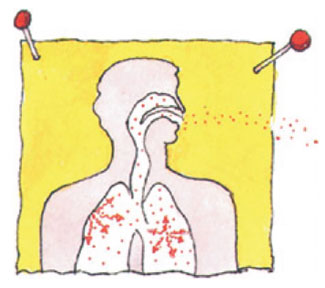Testing for Radon in Homes with Chemical Vapor Intrusion
Even if testing shows that you don’t have a vapor intrusion problem, you could still have a radon problem. Vapor intrusion investigations usually don’t test for radon, even though radon gets into your home the same way that chemical vapors do.
Read on to learn more about radon, radon testing, and reducing radon in your home.
Radon is a gas created when uranium breaks down. You can’t see it, smell it, taste it, or feel it. Uranium is found in small amounts in most rocks and soil. It slowly breaks down into other radioactive products including radon. Radon gives off radiation as it continues to break down into other radioactive elements.
If radon is getting into a home that is not well ventilated, it can build up to levels that may cause health problems.
Radon gives off radiation and radioactive particles. The particles can hurt your lungs. Breathing in radon raises the risk of getting lung cancer. Smoking cigarettes in addition to breathing radon raises the risk of lung cancer even higher.
Chemical vapor intrusion is a way that volatile chemical contaminants in soil and groundwater can enter and build up in air inside buildings.

Radon can cause lung cancer. The longer you breathe radon, the higher your risk of lung cancer.
Image Source: NIEHS. Accessed 1/10/17
https://www.niehs.nih.gov/health/topics/agents/radon/index.cfm
Fixing a typical stand-alone home ranges from $800 to $2,500. The cost depends on your home characteristics and which methods are needed to reduce the radon intrusion. Special loans from the Department of Housing and Urban Development may be available for some radon housing repairs.
If you live in a radon-prone area, consider testing for radon before you try to sell your home. Radon testing and installing a working radon reduction system can be a strong selling point when you put your home on the market.
Yes! Radon venting systems that use a fan to remove soil gas from beneath the building can decrease radon indoors by up to 99%. A soil ventilation system that removes chemical vapors will also help remove radon gases.
The U.S. Environmental Protection Agency (EPA) does not regulate naturally occurring radon in your home. However, the EPA, ATSDR, and other agencies have information about ways to reduce radon exposures and protect your health.
The U.S. Surgeon General urges all U.S. residents to get their homes tested for radon. Testing is the only way to know how much radon is in your home. Some regions of the U.S. have more radon than others, but homes with high levels can be found all over the country. Both ATSDR and EPA recommend testing your home for radon.
- Test your home during the time of year when windows are usually closed.
- Keep windows and outside doors closed at least 12 hours before beginning your radon test.
- Use a simple test kit available from your state radon office or local hardware store. The U.S. EPA Radon site explains how to use the test kit.
When you get your radon test results back, take action depending on your radon level. Radon is measured in picocuries per liter (pCi/L), a measure of radioactivity in air.
If your levels are
- 4 or higher – take action as soon as possible to reduce radon levels in your home.
- Between 2 and 4 – consider fixing your home.
- 2 or lower – retest every 2 years.
Lowering your exposure to radon in any amount decreases your cancer risk.
- Hire a qualified radon service professional to install a simple venting system to pull radon gases and other vapors from beneath your home and safely release them outside.
- Ask a radon professional to seal cracks in your flooring and cover sumps. Depending on the type of foundation, professionals may use other methods to stop the radon gas from getting into your home. See more information on how to reduce radon levels in your home in U.S. EPA’s “Consumer’s Guide to Radon Reduction: How to Fix Your Home”.
Radon decay products tend to attach to smoke which can stick inside the lungs and increase the radiation dose.1 The risk of getting lung cancer from breathing radon may be up to ten times greater for smokers than for nonsmokers. If you smoke, avoid smoking indoors to help protect your family members from the risks of second hand smoke.
Radon decay products attach to aerosols (dust and small particles suspended in air) which can stick inside the lungs and increase the radiation dose. U.S. EPA recommends you properly install, use, and maintain your stoves, heaters, furnaces, central heating systems, and woodstoves to reduce exposure to dust and particles in your home. See more tips at https://www.epa.gov/indoor-air-quality-iaq/indoor-particulate-matter.

Radon test kit materials. Source: Health Housing Reference Manual, HHS and HUD. 2006. Available at: https://www.cdc.gov/nceh/publications/books/housing/housing_ref_manual_2012.pdf
- Learn more about vapor intrusion: ATSDR Vapor Intrusion Fact Sheet https://www.atsdr.cdc.gov/vapor-intrusion.html
- Read “Protect Yourself and Your Family from Radon” https://www.cdc.gov/radon/
- Read “A Citizen’s Guide to Radon: The guide to protecting yourself and your family from radon” https://www.epa.gov/sites/production/files/2016-02/documents/2012_a_citizens_guide_to_radon.pdf
- Buy a radon test kit: U.S. EPA Radon site https://www.epa.gov/radon/find-radon-test-kit-or-measurementand-mitigation-professional
- Learn how to fix your home: U.S. EPA’s “Consumer’s Guide to Radon Reduction” https://www.epa.gov/sites/default/files/2016-02/documents/2013_consumers_guide_to_radon_reduction.pdf
- Get a loan to help reduce radon in your home: U.S. EPA Radon and Real Estate Resources https://www.epa.gov/radon/radon-and-real-estate-resources
- Read about radon health effects: ATSDR Toxicological Profile https://www.atsdr.cdc.gov/toxprofiledocs/index.html?id=407&tid=71
- Read “Improving Indoor Air Quality” https://www.epa.gov/indoor-air-quality-iaq/improving-indoor-airquality
1 “EPA Assessment of Risks from Radon in Homes” offers in-depth analysis at https://www.epa.gov/sites/production/files/2015-05/documents/402-r-03-003.pdf